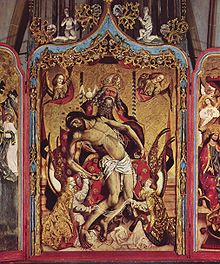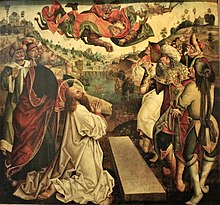Jan Polack
Jan Polack (* around 1450, presumably in Krakow , † 1519 in Munich ; also Pollack , Pöllack , Polegkh , Polak , Joannes Alasco Polonus ) was a late Gothic painter .
origin
Based on his last name, it is believed that he came from Poland ; it is controversial whether he worked there longer. After his apprenticeship, he went on a journey to Franconia and probably also to the Netherlands, then came to Munich around 1475, where he settled and founded his own workshop as early as 1478. His first demonstrable commission was the fresco cycle in the choir of St. Wolfgang in Pipping near Munich. In 1482 his name can also be found in the tax register of the city of Munich, although details of the previous years are missing, as the annals from 1462–1481 are no longer available.
plant
Polack is considered to be one of the most important and most productive late Gothic painters in the Munich area, whose work still had a lasting influence on the following generation of painters and also gained national importance. After his presumed marriage to the daughter of the Munich glass painter 'Meister Martin' , in whose workshop he worked, he was a respected citizen of the city endowed with all rights and was elected to the board of the painters' guild for a longer period of time (from 1485 to 1519), which is due to his great recognition among his painting colleagues.
Polack acquired his knowledge in the field of painting at the time as a journeyman on a journey to the painting centers of his time, whereby his work could be influenced by Michael Wohlgemut , Veit Stoss and Hans Pleydenwurff . He had an intimate friendship with the carver Erasmus Grasser , which was based on the common design of altarpieces through the kind of combination of image and carving that was common at the time.
During his creative period, Polack made numerous multi-part, convertible winged altars, individual panel paintings and frescoes in his painting workshop. Since 1488 he was the publicly “appointed” town painter and was additionally commissioned to make frescoes on the town gates. Documented and preserved works from his hand are the multi-winged high altar in Weihenstephan near Freising , created between 1482/83 and 1489, five of the original eight panels of which are now kept in the Domberg Museum in Freising and in the Bavarian State Painting Collection in Munich, the paintings of the high altar in Blutenburg Castle (1491) with the famous mercy seat and the altar wings of the former Franciscan Church of St. Antonius ( Barfüßer Order) from 1491/92, which are kept in the museum after the demolition. The multi-wing high altar of the Munich parish church of St. Peter on Petersplatz, made around 1490, also emerged from his workshop. Individual panels from the legend of St. Peter can still be found on the wall in the chancel of the church.
Other documented works, especially the frescoes in Munich, are of course no longer available due to the age, but they related to the inner city wall ring of the fortifications around Munich in the Middle Ages (city gates).
See also
- Blutenburg Palace Chapel (Blutenburg master and workshop of Jan Polack).
- St. Maria (Thalkirchen)
literature
- Hanna Bösl: Jan Polack. Pannonia-Verlag, Freilassing 1988, ISBN 3-7897-0135-1 ( Small Pannonia series 135).
- Christiane Kant: The Munich city painter Jan Polack as a portrait painter. Berlin 1997 (Berlin, Humboldt-Univ., Mag. Thesis, 1997).
- Andrea Langer: Jan Polack. In: New German Biography (NDB). Volume 20, Duncker & Humblot, Berlin 2001, ISBN 3-428-00201-6 , p. 593 f. ( Digitized version ).
- Peter Steiner, Claus Grimm (eds.): Jan Polack. From the drawing to the picture. Painting and painting technique in Munich around 1500. Catalog No. 49/04 from the House of Bavarian History. Augsburg 2005, ISBN 3-927233-96-X .
Web links
- Works by Jan Polack at Zeno.org .
- Literature by and about Jan Polack in the catalog of the German National Library
| personal data | |
|---|---|
| SURNAME | Polack, Jan |
| BRIEF DESCRIPTION | late Gothic painter |
| DATE OF BIRTH | around 1450 |
| PLACE OF BIRTH | uncertain: Krakow , Poland |
| DATE OF DEATH | 1519 |
| Place of death | Munich |

